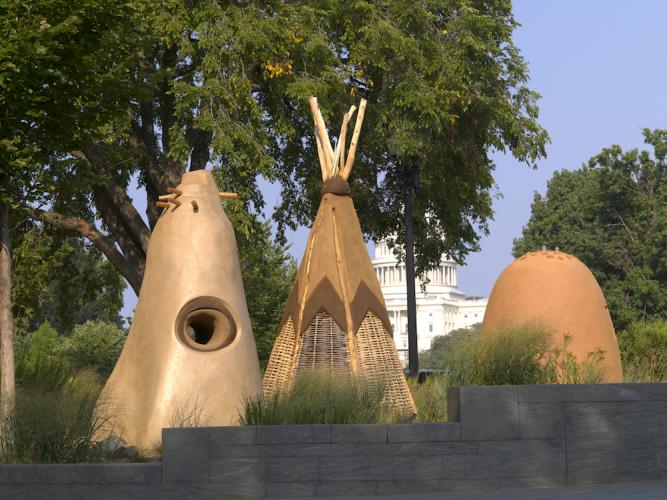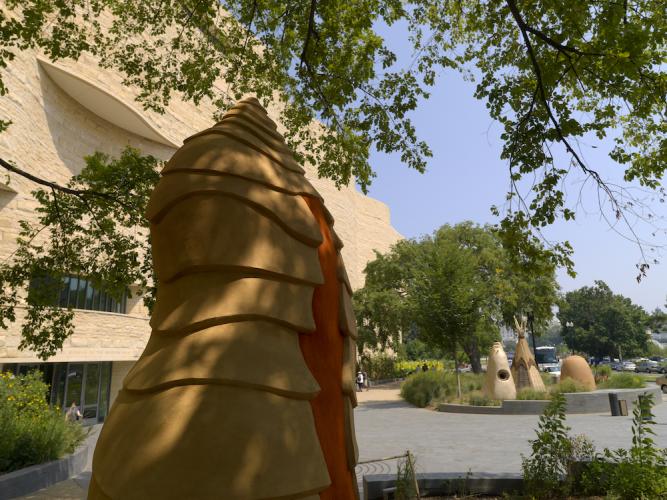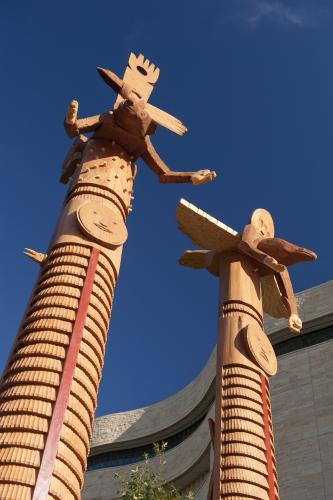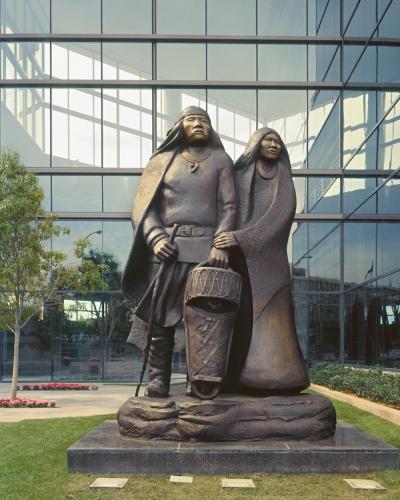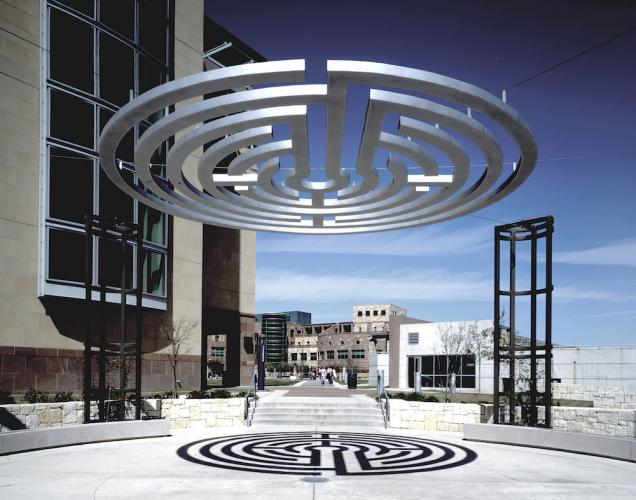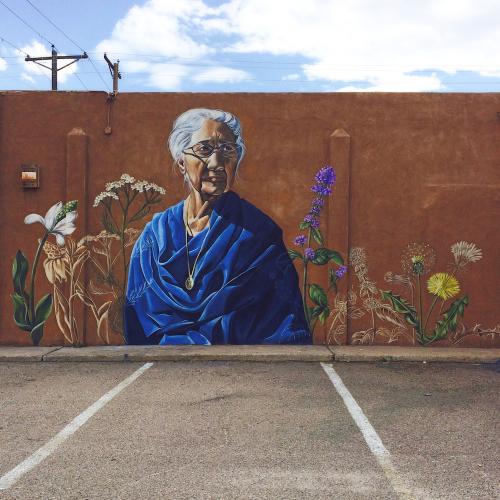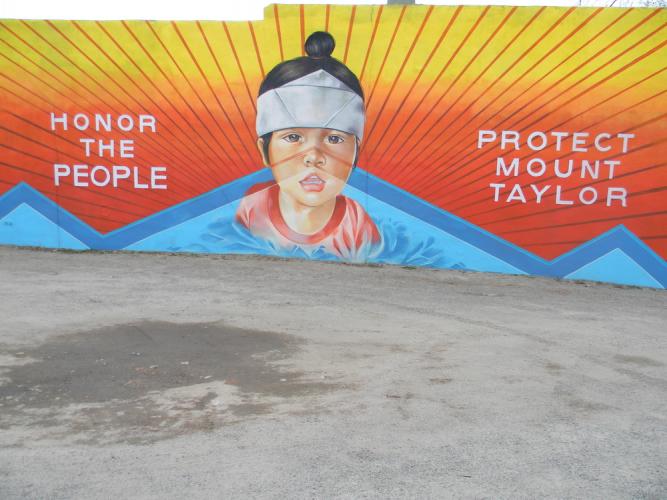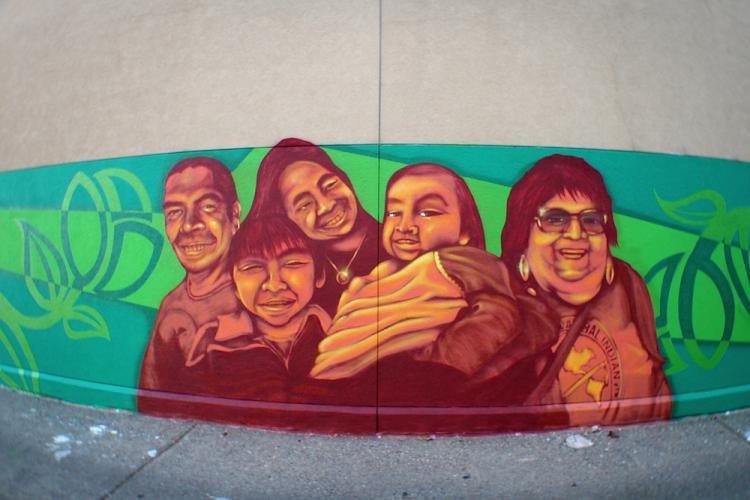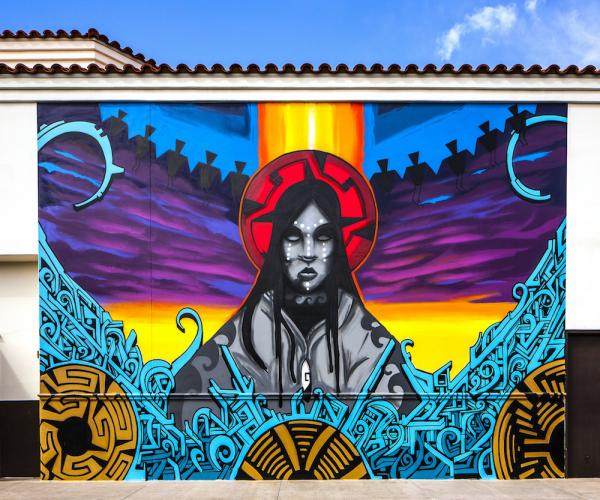Works of public art, sculptures and installations in open spaces have always been a strong component of the National Museum of the American Indian. They will become more prominent as the Museum develops a National Native American Veterans memorial on our grounds.
The Veterans Memorial will join other art works already facing the Museum and will enhance a growing tradition of American Indian artists working in statuary, murals and other installations designed for public view.
This May, Congress approved a bill for a National Native American Veterans Memorial which will allow “all Americans the opportunity to learn of the proud and courageous tradition of service of Native Americans in the Armed Forces of the United States.” The Museum is managing the Memorial project, working in concert with the National Congress of American Indians and other Native organizations. The Memorial’s final design will be selected by jury. It is scheduled for dedication in four years.
The Memorial isn’t the first public art to complement the D.C. Museum’s striking facade and landscape of indigenous flora.
During the summer of 2007, visitors to the Museum witnessed the creation of a group of five clay sculptures by Nora Naranjo-Morse (Santa Clara Pueblo). Entitled Always Becoming, the sculptures sit amongst the tall grasses by the building’s south entrance. They represent a family, each with its own name: Father, Mother, Little One, Moon Woman and Mountain Bird. Naranjo-Morse’s design was selected unanimously from more than 55 entries submitted by Native artists. The sculptures are composed entirely of natural materials, such as clay, straw, sand, dirt and wood. As she explained, “Native culture and the environment served as the inspiration… The sculptures’ metaphor of community, home and family not only conveys a universal theme to all peoples, but also enhances visitors’ experiences that they have entered a Native place when they step foot on the Museum grounds.” Naranjo-Morse worked communally with family, friends and Museum staff to build the works, some rising 16 feet in height. Dedicated during the building’s third anniversary, the conical and orbicular shapes of Always Becoming pair nicely with the curvilinear architecture of golden-colored Kasota limestone.
Years later the Museum commissioned another outdoor sculpture for its northwest corner, overlooking the National Mall. Oregon artist Rick Bartow (Mad River Band Wiyot, 1946–2016) designed and carved a pair of cedar poles called We Were Always Here as welcoming sentinels. Bartow secured the old-growth red cedar tree from renowned carver Duane Pasco, on whose property the 400-year-old tree had fallen. Bartow worked on the poles with expert woodworker John Paden in his hometown of Newport, Ore., as community members came to watch and carve small sections. Atop the 20-foot poles sit a bear and a raven, principal animals in the region that act as protectors and teachers. According to Bartow, the pleated, wave-like pattern on the base of the poles represents both “the tides changing on the mudflats” and “the movement down to generations or up through the generations” of families. The poles traveled across the country and were dedicated during the autumnal equinox in 2012.
Near the Museum’s east entrance, Buffalo Dancer II stands 12 feet in height and weighs one ton. Installed in 2009, the towering bronze sculpture by George Rivera (Pojoaque Pueblo) depicts a dancer, with arms raised, giving thanks during the ceremonial buffalo dance. Like these three works, public art takes many forms and exists outside museum and gallery walls. Viewers do not need to wait for open hours or pay admission. Philosophy scholar David H. Fisher defines public art as that which “potentially includes all forms of creative expression in [a] public space.” For art created by Native people, this definition could encompass ancient works such as rock painting or carving and Mississippian mounds, even though the original intention has been obscured.
Likewise, public art may include works that are memorials (a commemoration of an event or people), murals (two-dimensional wall paintings and mosaics), place-specific (designed for a particular location) and collaborations (a combined work between artists and a community). Works can be found in places where they are least expected, such as airports and city sidewalks. Public art can be ephemeral, lasting for a short time, as in the case of earthworks and other organically constructed installations, which are meant to decompose and to be subject to the forces of nature.
Murals have also been a prominent feature of public art, especially since the public works programs of President Franklin Roosevelt’s New Deal. Some 10,000 artists received work from federal programs, among them many Native artists. In 1934, the Indian Division of the Public Works of Art Project (PWAP) established its headquarters at the Santa Fe Indian School and aimed to “give artists employment at craftsmen’s wages in the embellishment of public property with works of art.” Thirty artists were selected to participate, including Velino Herrera (Zia, 1902–1973), Jack Hokeah (Kiowa, 1901–1969), Tonita Pena (San Ildefonso, 1893–1949), Andy Tsinhnahjinnie (Navajo, 1916–2000) and Pablita Velarde (Santa Clara, 1918–2006).
The U.S. Treasury’s Section of Fine Arts replaced PWAP and awarded commissions to artists to decorate public buildings, including post offices. A web-based virtual exhibition recently organized by the National Museum of the American Indian and the National Postal Museum, both part of the Smithsonian, documents the post office murals. The site includes images of murals by Acee Blue Eagle (Pawnee/Muscogee, 1909–1959), Woody Crumbo (Potawatomi, 1912–1989), Solomon McCombs (Muscogee, 1913–1980), Stephen Mopope (Kiowa, 1898–1974), Andrew Standing Soldier (Oglala, 1917–1967) and Dick West (Southern Cheyenne, 1912–1996).
Perhaps some of the best-known murals by Native artists are in the Department of the Interior building in Washington, D.C. In 1937, six Native artists received commissions to paint murals in the new building. Surrounding every wall of the former employee’s lounge or the penthouse are vibrant murals by Crumbo, Herrera, Allan Houser (Chiricahua Apache, 1914–1994) and Gerald Nailor (Navajo, 1917–1952). They depict genre scenes of dances, hunting and domestic life. In the basement, the large cafeteria features frieze-like murals of dances by Mopope and James Auchiah (Kiowa, 1906–1974). Houser and Nailor also painted murals in the Indian Craft Shop on the ground level of the building.
Nailor received another major commission, funded by the Civil Works Administration, to paint eight murals surrounding the interior chamber of the Navajo Nation Council House in Window Rock, Ariz. Titled The History and Progress of the Navajo People (1942–43), the murals read counterclockwise and show the life of the Navajo from before European contact to the present day. The final mural depicts a young Navajo man and woman in modern attire, which some interpret as First Man and First Woman embodied in today’s Navajo people.
When Houser completed the monumental sculpture Comrade in Mourning in 1948, it marked the first major sculptural commission to an American Indian artist. The sculpture honors Native students from Haskell Institute (now Haskell Indian Nations University) who died in World War II. From that moment, Houser went on to create numerous three-dimensional works, establish the sculpture department at the Institute of American Indian Arts in Santa Fe and become known as the father of American Indian sculpture.
During his lifetime, Houser produced nearly 1,000 sculptures in wood, stone and bronze. His bronze works are in outdoor spaces throughout the United States. They include As Long as the Water Flows (1988), in front of the Oklahoma State Capitol in Oklahoma City, and The Future (1985) in downtown Albuquerque, both 14 feet in height.
Minnesota artist George Morrison (Grand Portage Band of Chippewa, 1919–2000), often known for his paintings of Lake Superior and his intricate wood collages, has produced a number of public artworks across his home state. One of his first was a commission for a monumental wood collage for the facade of the Minneapolis American Indian Center. Dedicated in 1975, the work is a series of geometric wooden chevron shapes, spanning 98 feet in length and 18 feet high. Morrison received several other commissions, including Tableau in 1992, a granite and concrete mosaic of more than 200 interlocking amorphous figures on a sidewalk in downtown Minneapolis. Street renovations have placed the work in storage until the city can find another location, but as Mary Altman, Minneapolis Public Arts Administrator commented, “it’s probably one of the most important artworks the city owns.”
Morrison’s art can also be found on college campuses. One of his rectangular totems, which rises 14 feet, is located at the Minneapolis Community and Technical College. His five-foot tall Churinga, an oblong-shaped bronze named after a sacred item of the indigenous people of central Australia, rests on top of an igneous rock near the entrance to the Fond Du Lac Tribal Community College in Cloquet, Minn. At the same campus, Truman Lowe (Ho-Chunk) created Ojibway Stream, a serpentine work of stainless steel and river rocks which comments on the importance of water.
University campuses across the country feature more works by Native artists. Lewis deSoto (Cahuilla), for example, created Labyrinth Gateway at the University of Texas San Antonio, in 2003. The work features a steel sculpture suspended above a courtyard by cables and mounted to pylons. As the sun passes overhead, it creates a large shadow of a labyrinth on the ground. People are encouraged to walk its path. On the outer edges, two large semicircular benches are incised with quotations from Tomas Rivera (1935–1984), a professor at the university and a poet of the Chicano Literary Movement. From the ground, the labyrinth seems to float in air.
Certain cities in the United States have a number of public works by Native artists. In central Phoenix, at the intersection of North Central Ave. and East Thomas Rd., is a monumental bronze sculpture by Doug Hyde (Nez Perce/Assiniboine/Chippewa), a student of Houser and an alumnus and former instructor at the Institute of American Indian Arts. Dedicated in 1989, a Tribute to Navajo Code Talkers depicts a seated Navajo man, who holds a flute symbolizing communication and peace. As explained on the plaque, the work honors the “more than 400 U.S. Marines who bravely served their country during World War II” by creating an unbreakable secret code based on the Navajo language.
At the western border of the Phoenix Sky Harbor International Airport stands a series of tall steel sculptures, Hohokam #1 (1990), by Bob Haozous (Chiricahua Apache), each depicting pre-Columbian bird forms surrounded by airplanes. The work comments on the erasure of the indigenous presence on the land by technology. In 2014, the Phoenix Office of the Arts and Culture Public Art program along with the Phoenix Aviation Department selected Janelle L. Stanley, a Navajo weaver from Arizona, as one of the artists to design terrazzo platforms leading to the terminals. Stanley adapted Navajo weaving into her work Diné, which depicts blue and black strands of wool twisting together, surrounded by grey diamond shapes. Her second work, Haak’u/Acoma Connection, utilizes Acoma Pueblo pottery designs surrounding a golden yellow pathway.
Alaska is also home to a number of public artworks by Native artists, in addition to its numerous indigenous cedar poles, house posts and carvings. Outside the entrance to the Fairbanks International Airport is a group of five stainless-steel figures curling and bending on steel bases. Installed in 2008, Migrations is a work by Mark Fejes and Ron Senungetuk (Inupiaq). Senungetuk etched imagery of Inupiaq hunting and fishing migrations on each surface. At the Anchorage International Airport is a wood panel Old Bering Sea by Senungetuk, along with works by other Alaska Native artists such as the carving The Catch by Nathan Jackson (Chilkoot-Tlingit) and Blue Jay Spirit-Helper by John Hoover (Aleut, 1919–2011). Hoover also created the wooden sculpture of migratory birds at the Alaska Native Medical Center and the red cedar sculpture Volcano Woman at the Egan Center in Anchorage, which also features the wood and whalebone sculptural commission Eskimo Spirit Carvings, by Melvin Olanna (Inupiaq, 1941–1991).
Since many Native people live in urban areas, cities are abundant sites of murals by Native artists. Raised in Minneapolis, Bobby Wilson (Sisseton-Wahpeton Dakota) has created numerous murals in his hometown as well as in Rapid City and Phoenix. Throughout Phoenix, the murals of Thomas “Breeze” Marcus (Tohono O’odham) feature his unique and intricate linework, which draws from hieroglyphics as well as O’odham basket patterns. Nanibah “Nani” Chacon (Navajo) is known for her paintings of powerful female figures, and her large-scale murals are found in Albuquerque and Santa Fe in New Mexico and Izhevsk in Russia. As well as being a performance artist, Gregg Deal (Pyramid Lake Paiute) has created politically charged murals in the D.C.-area on issues such as the presidential election and Indian mascots.
This is far from a comprehensive list. Native people have made public art since ancient times. These works may take two-dimensional or three-dimensional forms and may be composed of a range of materials, from organic to human-made. Nonetheless, these works speak to the role art plays as communication, connecting diverse people in public spaces. Likewise, they stand as markers of memory and the continued presence of indigenous people in the United States.
RICK BARTOW ART ON VIEW AT YALE UNIVERSITY
Five rarely seen works on paper by the late artist Rick Bartow (Mad River Band Wiyot, 1946–2016) went on view at the Yale University Art Gallery in New Haven, Conn., this June. The drawings date to 1985 and 1986, the early years of Bartow’s career and exhibit themes that would continue to engage him.
The drawings at Yale show how his work often blends human and animal bodies in what appear to be states of transformation. Bartow, who lived along the Oregon coast, was a keen observer of ravens, coyotes and other creatures. He explained, “I often think in the drawings it is more of an ecological statement that we are no greater than [the animals] are, and they are no greater than we are.”
These works came into the gallery’s collection in 2009 as part of a major gift from Richard Brown Baker, a prodigious collector and Yale alumnus with an eye for emerging artists. Baker encountered Bartow’s work in 1985 during a trip to Portland and immediately purchased three for his Manhattan apartment. He added four more drawings to his collection and noted in his 1987 diary, “I cherish the hope that Bartow will continue to produce and gain admirers, of whom I am among the first, I’d like to imagine, of many hundreds to come.” Bartow, who passed away on April 2 of this year, became a widely celebrated American artist who worked prolifically in a wide range of media including oil pastel, acrylic and wood.
The installation aligns with a major retrospective, Rick Bartow: Things You Know but Cannot Explain, touring American museums in the West through 2019. The Yale showing was proposed and organized by Sequoia Miller and this writer, two Ph.D. candidates at Yale University. The gallery has launched a Native American Art Initiative, which raises awareness of the role of indigenous North American artists with works in the collection.
DEPICTING ONATE
Public art is not without its controversies. For New Mexico’s Cuarto Centenario or the 400th anniversary of Spanish explorer Don Juan de Onate’s 1598 arrival into the present-day state, members of the state’s Hispanic organizations proposed a bust of Onate to be placed in Albuquerque’s Old Town. As one proponent remarked, “It was not the pilgrims; it did not happen at Jamestown or at Plymouth Rock. The first permanent European settlement flew the Spanish flag, here in New Mexico; they were our forefathers, and we are proud of them.”
But Onate embodied a different legacy to Pueblo people. In December 1598, Acoma Pueblo men killed 12 Spanish soldiers. In retribution, the Spanish soldiers killed 100 Acoma men and enslaved 60 women and girls. The surviving Acoma men had their right foot cut off, as a brutal symbol of Spanish force. In 1613, Onate was tried as a war criminal in Mexico City and was banished permanently from New Mexico.
Many Native people protested the sculpture. The Albuquerque Arts Board formed a committee in response to the controversy. The board approved a memorial to Onate near the Albuquerque Museum but mandated that a Native artist be involved, along with the existing Hispanic and Anglo artists, Reynaldo “Sonny” Rivera and Betty Sabo. Santa Clara artist Nora Naranjo-Morse was asked to join the project after the design had been agreed upon.
The ensuing community conversations revealed the various ways that people wished their histories to be remembered. In the end, the plan for a single, tri-cultural work evolved into two different sculptures. Rivera and Sabo designed a multi-figured bronze ensemble called La Jornada (“The Journey”) depicting Onate leading a group of Spanish settlers, a Catholic priest, a Mexican Indian guide and soldiers to New Mexico. Naranjo-Morse wanted to approach the theme like Always Becoming, from the land base, from the environment. She created an earthwork entitled Numbe Whageh or “our center place,” a spiral mound which winds into a small spring or “a womb” at the center, surrounded by indigenous plants.

